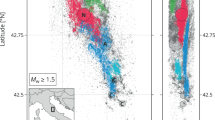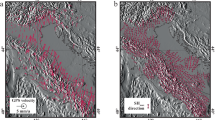Abstract
Every gigantic earthquake begins as a tiny rock failure at almost a point, followed by successive slip of the complex fault system, before radiating strong shaking from a vast rupture area extending over hundreds of kilometres. Whether the growth process of the rupture of a large earthquake is predictable and whether it produces observable signatures different from that of smaller events1,2,3,4,5 are fundamental questions related to the potential for earthquake early warning and probabilistic forecasting. Inspired by a recent discovery that large earthquakes might have seismic waves, and probably rupture processes, that are almost identical to those of smaller events6,7,8, we show that such similarity characterized by large cross-correlation is a common feature of earthquakes in the Tohoku–Hokkaido subduction zone, Japan. A systematic comparison of 15 years of high-sensitivity seismograph records for approximately 100,000 events reveals 80 extremely similar and 390 very similar pairs of large (moment magnitude M > 4.5) and small (M < 4.0) earthquakes, co-located within about 100 metres. An extremely high similarity is observed for pairs of subduction-type earthquakes (170 of 899 large events) separated by a long period of up to 15 years, whereas for pairs of other types of large earthquakes only the foreshocks and aftershocks are similar. This frequently occurring similarity between different-sized subduction-type earthquakes suggests repeated cascading rupture processes in a widespread hierarchical structure9,10,11,12 along the plate interface and indicates a specific but probabilistically limited predictability of the final size of the earthquake (that is, the location and a set of possible sizes of an earthquake are well predicted, but its final size is not at all well constrained).
This is a preview of subscription content, access via your institution
Access options
Access Nature and 54 other Nature Portfolio journals
Get Nature+, our best-value online-access subscription
$29.99 / 30 days
cancel any time
Subscribe to this journal
Receive 51 print issues and online access
$199.00 per year
only $3.90 per issue
Buy this article
- Purchase on Springer Link
- Instant access to full article PDF
Prices may be subject to local taxes which are calculated during checkout




Similar content being viewed by others
Data availability
All waveform data are available from the NIED Hi-net server (http://www.hinet.bosai.go.jp).
References
Umeda, Y. High-amplitude seismic waves radiated from the bright spot of an earthquake. Tectonophysics 175, 81–92 (1990).
Iio, Y. Slow initial phase of the P-wave velocity pulse generated by microearthquakes. Geophys. Res. Lett. 19, 477–480 (1992).
Ellsworth, W. L. & Beroza, G. C. Seismic evidence for an earthquake nucleation phase. Science 268, 851–855 (1995).
Mori, J. & Kanamori, H. Initial rupture of earthquakes in the 1995 Ridgecrest, California sequence. Geophys. Res. Lett. 23, 2437–2440 (1996).
Meier, M. A., Heaton, T. & Clinton, J. Evidence for universal earthquake rupture initiation behavior. Geophys. Res. Lett. 43, 7991–7996 (2016).
Meier, M. A., Ampuero, J. P. & Heaton, T. H. The hidden simplicity of subduction megathrust earthquakes. Science 357, 1277–1281 (2017).
Okuda, T. & Ide, S. Hierarchical rupture growth evidenced by the initial seismic waveforms. Nat. Commun. 9, 3714 (2018).
Okuda, T. & Ide, S. Streak and hierarchical structures of the Tohoku–Hokkaido subduction zone plate boundary. Earth Planets Space 70, 132 (2018).
Ide, S. & Aochi, H. Earthquakes as multiscale dynamic ruptures with heterogeneous fracture surface energy. J. Geophys. Res. Solid Earth 110, B11303 (2005).
Aochi, H. & Ide, S. Complexity in earthquake sequences controlled by multiscale heterogeneity in fault fracture energy. J. Geophys. Res. Solid Earth 114, B03305 (2009).
Noda, H., Nakatani, M. & Hori, T. Large nucleation before large earthquakes is sometimes skipped due to cascade-up—implications from a rate and state simulation of faults with hierarchical asperities. J. Geophys. Res. Solid Earth 118, 2924–2952 (2013).
Uchida, N. et al. Source parameters of a M4.8 and its accompanying repeating earthquakes off Kamaishi, NE Japan: implications for the hierarchical structure of asperities and earthquake cycle. Geophys. Res. Lett. 34, L20313 (2007).
Nadeau, R. M. & Johnson, L. R. Seismological studies at Parkfield VI: moment release rates and estimates of source parameters for small repeating earthquakes. Bull. Seismol. Soc. Am. 88, 790–814 (1998).
McGuire, J. J. Seismic cycles and earthquake predictability on East Pacific Rise transform faults. Bull. Seismol. Soc. Am. 98, 1067–1084 (2008).
Chen, K. H., Nadeau, R. M. & Rau, R. J. Characteristic repeating earthquakes in an arc-continent collision boundary zone: the Chihshang fault of eastern Taiwan. Earth Planet. Sci. Lett. 276, 262–272 (2008).
Uchida, N. & Matsuzawa, T. Pre- and postseismic slow slip surrounding the 2011 Tohoku-oki earthquake rupture. Earth Planet. Sci. Lett. 374, 81–91 (2013).
Schorlemmer, D. et al. The collaboratory for the study of earthquake predictability: achievements and priorities. Seismol. Res. Lett. 89, 1305–1313 (2018).
Abercrombie, R. E. & Mori, J. J. Local observations of the onset of a large earthquake: 28 June 1992 Landers, California. Bull. Seismol. Soc. Am. 84, 725–734 (1994).
Shibazaki, B., Yoshida, Y., Nakamura, M., Nakamura, M. & Katao, H. Rupture nucleations in the 1995 Hyogo-ken Nanbu earthquake and its large aftershocks. Geophys. J. Int. 149, 572–588 (2002).
Uchide, T. & Ide, S. Scaling of earthquake rupture growth in the Parkfield area: self-similar growth and suppression by the finite seismogenic layer. J. Geophys. Res. Solid Earth 115, B11302 (2010).
Singh, S. K. et al. Implications of a composite source model and seismic-wave attenuation for the observed simplicity of small earthquakes and reported duration of earthquake initiation phase. Bull. Seismol. Soc. Am. 88, 1171–1181 (1998).
Dodge, D. A., Beroza, G. C. & Ellsworth, W. L. Foreshock sequence of the 1992 Landers, California, earthquake and its implications for earthquake nucleation. J. Geophys. Res. Solid Earth 100, 9865–9880 (1995).
Bouchon, M. et al. Extended nucleation of the 1999 Mw 7.6 Izmit earthquake. Science 331, 877–880 (2011).
King, G. The accommodation of large strains in the upper lithosphere of the earth and other solids by self-similar fault systems: the geometrical origin of b-value. Pure Appl. Geophys. 121, 761–815 (1983).
Okubo, P. G. & Aki, K. Fractal geometry in the San Andreas fault system. J. Geophys. Res. Solid Earth 92, 345–355 (1987).
Ben-Zion, Y. & Sammis, C. G. Characterization of fault zones. Pure Appl. Geophys. 160, 677–715 (2003).
Candela, T. et al. Characterization of fault roughness at various scales: implications of three-dimensional high resolution topography measurements. Pure Appl. Geophys. 166, 1817–1851 (2009).
Dieterich, J. H. Earthquake nucleation on faults with rate-and state-dependent strength. Tectonophysics 211, 115–134 (1992).
Ohnaka, M. Earthquake source nucleation: a physical model for short-term precursors. Tectonophysics 211, 149–178 (1992).
Shibazaki, B. & Matsu’ura, M. Foreshocks and pre-events associated with the nucleation of large earthquakes. Geophys. Res. Lett. 22, 1305–1308 (1995).
McLaskey, G. C. & Kilgore, B. D. Foreshocks during the nucleation of stick-slip instability. J. Geophys. Res. Solid Earth 118, 2982–2997 (2013).
Suzuki, T. & Yamashita, T. Effects of shear heating, slip-induced dilatancy and fluid flow on diversity of 1-D dynamic earthquake slip. J. Geophys. Res. Solid Earth 119, 2100–2120 (2014).
Acknowledgements
This work was supported by funding from the Ministry of Education, Culture, Sports, Science and Technology (MEXT) of Japan, under its Earthquake and Volcano Hazards Observation and Research Program, JSPS KAKENHI 16H02219 and MEXT KAKENHI 16H06477. All data were obtained from the NIED Hi-net data server. Figures were prepared using the Generic Mapping Tools.
Author information
Authors and Affiliations
Corresponding author
Ethics declarations
Competing interests
The author declares no competing interests.
Additional information
Publisher’s note: Springer Nature remains neutral with regard to jurisdictional claims in published maps and institutional affiliations.
Extended data figures and tables
Extended Data Fig. 1 Comparison between the seismograms of large (black trace) and small (red trace) earthquakes for dissimilar onsets.
CCmax ≈ 0.6. ‘Bad example’ indicates that compared to many pairs having CCmax above 0.8, this value of 0.6 is small. The acceleration record, scaled by the noise level (left) and amplitude of the small event (middle left), and the velocity record, scaled by the onset of the small event (middle right) and large event (right), are shown for each station, with the appropriate scales shown in the bottom left-hand corner of each waveform set (micrometre per second per second for acceleration; micrometre per second for velocity). The grey box in each acceleration plot shows the time window used to calculate CCmax. The value of CCmax for each station is shown below the station name in each acceleration plot. The takeoff angle and azimuth (degrees) from the source to each station are shown below the station name in each velocity plot.
Supplementary information
41586_2019_1508_MOESM1_ESM.pdf
Supplementary Figures Comparison between the seismograms of large (black) and small (red) earthquakes. The 80 figures show details of the 80 earthquake pairs for which CCmax > 0.9 are presented. The information relating to the occurrence time (YYYYMMDDhhmmss), hypocentre locations, and magnitude of each event are provided in the upper left-hand corner of each page, along with the corresponding CCmax value. The acceleration record, scaled by the noise level (left) and amplitude of the small event (middle left), and the velocity record, scaled by the onset of the small event (middle right) and large event (right), are shown for each station, with the appropriate scales shown in the bottom left-hand corner of each waveform set (micrometre per second2 for acceleration; micrometre per second for velocity). The grey box in each acceleration plot shows the time window used to calculate CCmax. The value of CCmax for each station is shown below the station name in each acceleration plot. The takeoff angle and azimuth (degrees) from the source to each station are shown below the station name in each velocity plot
Supplementary Table 1
Earthquake pairs of the subduction type with CCmax >0.8.
Supplementary Table 2
Earthquake pairs of other type with CCmax>0.8.
Rights and permissions
About this article
Cite this article
Ide, S. Frequent observations of identical onsets of large and small earthquakes. Nature 573, 112–116 (2019). https://doi.org/10.1038/s41586-019-1508-5
Received:
Accepted:
Published:
Issue Date:
DOI: https://doi.org/10.1038/s41586-019-1508-5
This article is cited by
-
Study on the correlation between real-time GNSS landslide acceleration monitoring and earthquake response: a case of May 2, 2023, MW = 5.2 Baoshan earthquake, Yunnan
Geoenvironmental Disasters (2024)
-
Dynamic nucleation as a cascade-up of earthquakes depending on rupture propagation velocity
Earth, Planets and Space (2023)
-
A review on slow earthquakes in the Japan Trench
Progress in Earth and Planetary Science (2023)
-
The break of earthquake asperities imaged by distributed acoustic sensing
Nature (2023)
-
Identical Acoustic Waveforms Found Between Different-Sized Outbursts: Implications for the Propagation Mechanism of Coal and Gas Outbursts
Rock Mechanics and Rock Engineering (2022)
Comments
By submitting a comment you agree to abide by our Terms and Community Guidelines. If you find something abusive or that does not comply with our terms or guidelines please flag it as inappropriate.



